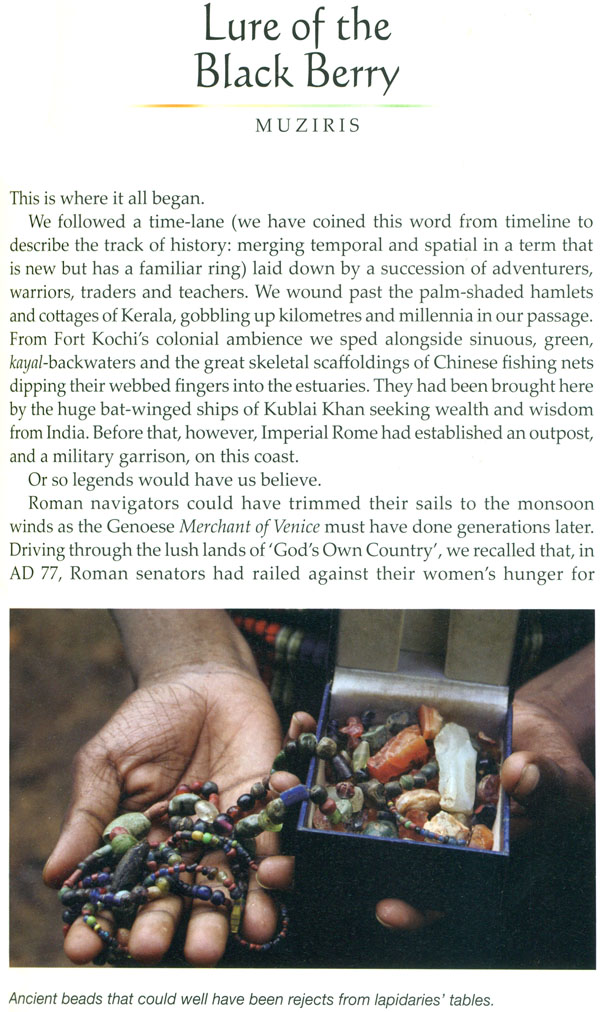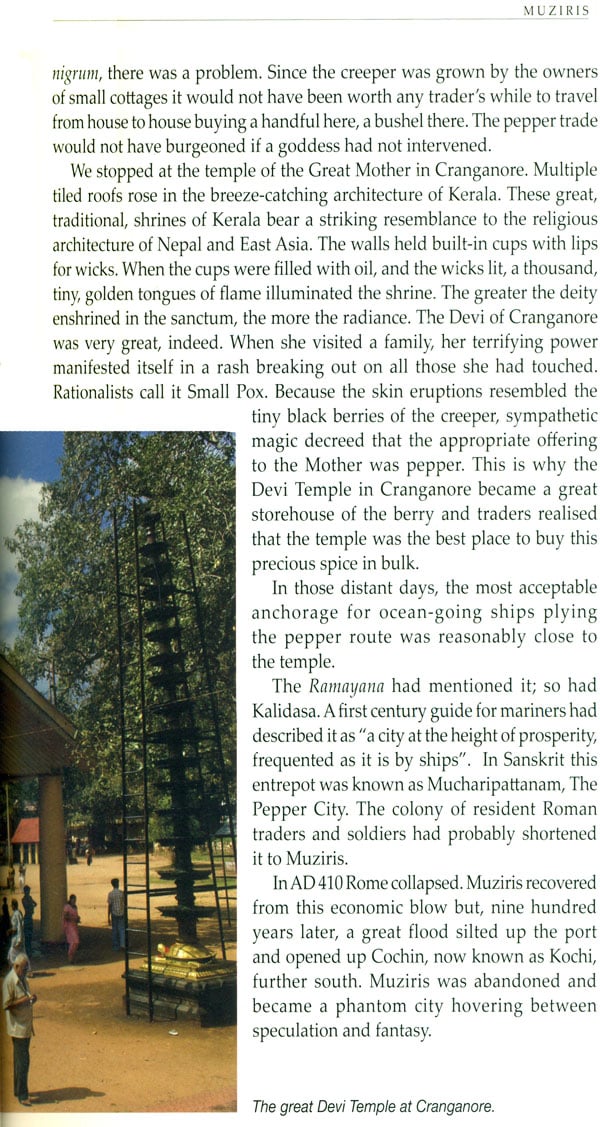
Intriguing India: The Historic South (A Travel Guide)
Book Specification
| Item Code: | NAI388 |
| Author: | Hugh and Colleen Gantzer |
| Publisher: | Niyogi Books |
| Language: | English |
| Edition: | 2010 |
| ISBN: | 9789381523414 |
| Pages: | 180 (Throughout Color Illustrations) |
| Cover: | Paperback |
| Other Details | 9 inch X 5.5 inch |
| Weight | 380 gm |
Book Description
About the Book
Stove Jobs discovered his genius in India. He found that creativity lies beyond weighing, measuring and deducing. He learnt the way of our savants, tapped intuition, married calligraphy to technology and triggered an IT revolution. In their travels around southern India, Hugh and Colleen Gantzer look beyond history. What is the link between Daroji in tropical Karnataka and till mysterious beast that prowls the snowy wastes of the High Himalayas? Why were boulders carved as temples of varied architectural styles in an ancient port? Did an extreme rural sport in Tamil Nadu originate thousands of year ago in the Mediterranean lands? Did supermen walk the earth in the sixth century HC and has the image of one been Captured in stone? This is not a book about history or archaeology or anthropology or any of the other very specialised sciences concerned with delving into the past, weighing and measuring it all, and presenting it is the mind of the historian sees it. History is, too often, his-story: the view of a specialist conforming to the rigours of his profession. That was not the intuitively unorthodox Stteve Jobs way. The Gantzers ask you to join them, as they let their intuitions roam freely to unravel the mysteries of Intriguing India.
Hugh and Colleen Gantzer live their dream. Colleen had always wanted to fly and she did pilot a plane in the Swiss Alps while Hugh sat behind saying a rosary, just in case! Hugh had longed to see those faraway places with their strange sounding names so he joined the Indian Navy. Hugh took premature retirement when he was the Judge Advocate of the Southern Naval Area and Hugh and Colleen decided to become a travel-writer-photographer team.
Suddenly, things changed. They found themselves surfing on the great travel wave that was sweeping across the world. In quick succession they launched India’s first travel column carried in all editions of national daily on the editorial page. They hosted fifty-two weekly episodes of Indian’s first nation-Wide TV travel show, wrote the first travel scripts for dot.Coms, won national and international awards, toured India and the world as guests of eager tourism organisation. They have, possibly, visited, photographed and written about more places in India than anyone else in the long history of our land.
Once, a greatly revered maternal uncle, who had just retired as India’s Naval Chief, had asked them, “How long more will you continue to travel?” That was before they were invited to a winter ball in Vienna. Today, for six months every year, when they’re not their Victorian cottage in the oak woods of the Himalayas, they’re still travelling... and they’re still having a ball.
The South has retained its anima.
This easily discernible identity of southern people has much to do with history.
Dravidian culture had millennia to strike deep roots without being churned by frequent immigrations. Their great cities became burgeoning bastions of their ancient culture giving them the assurance to welcome other people into their midst. The Aryans filtered in and established a loose priestly hierarchy. The first Jews Christians and Muslims to arrive in our land, set up their colonies in the south. So did the Portuguese, British, Dutch and French. But all of them, over the years, adopted some of the customs and traditions of the Dravidians.
In our travels in the south of our land we uncovered many intriguing nodes of this ancient culture. Here, because of its long continuity, thinkers were able to explore avenues that reached beyond the confines of logic and into areas that scientists are only now beginning to discover. At that time, western travellers were confounded by the achievements of our savants and wrote books like Paul Brunton’s In Search of Secret India, Alexandra David-Neel’s With Mystics and Magicians in Tibet. Other visitors trivialised it by conjuring up images of an India of snake charmers and the Indian Rope Trick. What could not be explained had to be either ridiculed or blurred because ‘East is East and the West is West and Never the Twain Shall Meet.’ But the twain did meet in unorthodox people like The Beatles and Steve Jobs.
We believe that many accessible avenues to our intuitive knowledge lie in the southern states. The more we probed the more we encountered a strange affinity between our people and the living and non-living world around us. It almost seems as if the makers of the cult film Avatar had Indians in mind when they created the symbiotes, the linked lives, in that distant planet.
In the South, we visited a place where wild birds treat the residents of a village with such reverence that they migrated with them when they had to evacuate their homes because of a plague. Then they flew back with them when they returned. In a shrine amidst wooded hills we saw the source of a great river that renews itself, on a specific date every year, in the presence of thousands of devotees. Deep in a sacred forest, we visited a serpent temple presided over by a priestess and saw a snake that is not supposed to exist. And in the temples of the Navagrahas we felt our cultural biases being shaken.
We have been enthralled by discoveries like these. It’s been an almost psychedelic experience, opening doors of perception that we did not know even existed. We had these brief satori moments without being students of Zen.
We believe that anyone can experience these ecstatic bursts of intuition if they look for the inexplicable and then ask themselves, “But why?” You, too, will have many opportunities to do this as you travel around Intriguing India.
| Preface | 7 |
| Lure of the Black Berry: Muziris | 9 |
| The Pageant of Lord Vadakkunathan: Trichur Pooram | 17 |
| The Shaman Encounter: Theyyam | 23 |
| Encounters in the Backwaters: Course of the Chundan Valloms | 31 |
| The Carry-away Homes of Kerala: Tarawads | 39 |
| The Prime Martial Arts: Kalarippayatu | 45 |
| The Archaic Aura of Mannarasala: The Serpent Temple | 53 |
| The Lake of the Pachyderms: Thekkady | 59 |
| Syrian Connections: The Thoman Inheritance | 65 |
| Constellation Trek: Star Gods | 73 |
| Midnight Warriors: The Aiyanars | 81 |
| The Pamplona Clone: Jallikattu | 85 |
| Traditionally International: The Mansions of Chettinad | 91 |
| The Many Shrines of History: Madurai | 97 |
| The Heritage Exporters: Mahabalipuram | 105 |
| Their Tenants Have Wings: Kokkare Bellur | 111 |
| Where the Bubbles Appear: Tala Cauvery | 119 |
| Dosa on the Rocks: Udupi | 129 |
| The Once and Future Colossus: Gommateshwara | 135 |
| Casting a Long Shadow: Hampi | 143 |
| Close Encounters of the Ursine Kind: Bear Delights | 151 |
| The Fortress of Diamonds: Golconda | 157 |
| The Power of the Talisman: The Charminar | 163 |
| Fantasy Unlimited: Dreamscapes | 169 |













